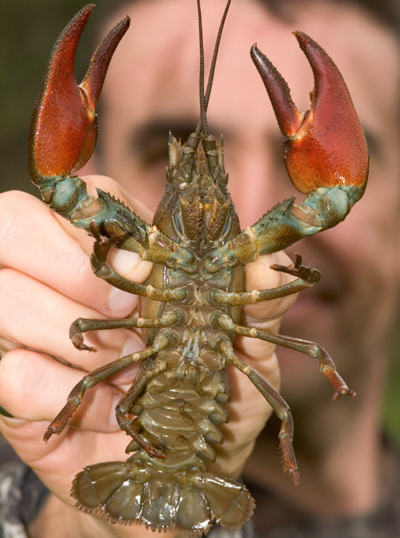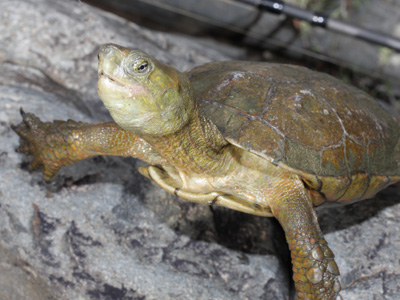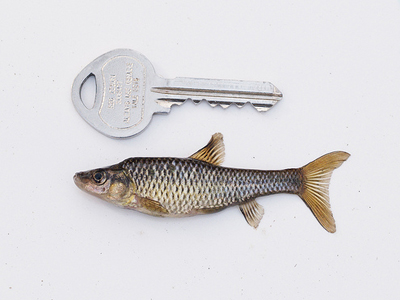Chinese Mitten Crab
The Chinese mitten crab originates from East Asia (the clue’s in the name!) and arrived in Britain by travelling in the ballast water of ships; they are currently present in the Thames, one or two other rivers, and some coastal areas.
They are considered an environmental threat as, given the right conditions, they will breed rapidly and feed on a wide range of native invertebrates and fish. Another serious problem caused by these crabs is their intensive burrowing, which if left unchecked destabilizes river banks, causing large amounts of damage.
Some good news however, since entering Britain they are not spreading as fast as was expected, though the full extent of their distribution is still unclear and scientists from the Natural History Museum are asking the general public to take part in a nationwide survey HERE to help find out.
Brown Goldfish
Introduced into Britain through the pet trade and probably deliberately released by people who could no longer care for them, or wanted their fish to live out the rest of their days in a big pond or lake rather than a little bowl. Whatever the reason for their release the brown goldfish has become something of a nuisance as they can compete with native fish for food and spawning sites, can carry non-native parasites that harm native species and they hybridise readily with native crucian carp, contributing to the decline of the latter in the UK.
 Signal Crayfish
Signal Crayfish
One of the biggest threats to fish in the UK is the signal crayfish, introduced about 30 years ago for aquaculture they escaped and soon became widespread across Britain. Other alien crayfish – such as the virile crayfish pictured above – are now also presnt in the UK, although not in the same numbers as the signal.
The aquatic equivalent of the grey squirrel, signals are fast growing and able to reproduce extremely quickly (probably what made them attractive for aquaculture to begin with) and they are able to quickly colonise and dominate a stretch of water from where they can then travel over land in order to take over the next one.
When adult they will feed on most small invertebrates and plants and they consume or outcompete native crustaceans, amphibians, and fish.
Like the mitten crab its burrows damage river verges, but worst of all it carries a lethal fungal infection which they are immune to, but which kills off our native white clawed crayfish further upsetting the ecological balance of rivers. All these negative features are offset by one thing however, they’re absolutely delicious, and eating them has the added benefit of decreasing their numbers thus aiding the efforts of conservationists!
 Red Eared Terrapin
Red Eared Terrapin
Like the brown goldfish the red eared terrapin was introduced to Britain via the pet trade. Not being the most agreeable, or easy to keep, of pets they have been widely released across Britain. There is little evidence of them breeding; however being an extremely voracious predator, any area they have been introduced in is likely to suffer a drop in the population of amphibians, invertebrates, fish and even waterfowl.
Interestingly there have been one or two incidences of the terrapin’s much larger cousin, the alligator snapping turtle, found in ponds in the UK (although never at full size), one of the largest freshwater turtles in the world specimens have been recorded at over 12 stone in weight and they have one of the most powerful bites in the animal kingdom, easily capable of tackling large prey.
These are one of the more unusual animals considered a possible candidate for the mysterious creature thought to be killing waterfowl on the Thames recently, alongside actual alligators – and the perhaps more likely wels catfish.
 Topmouth Gudgeon
Topmouth Gudgeon
A candidate for the most invasive fish species in the UK the topmouth gudgeon was introduced to Britain through the aquarium trade but has now established itself across many areas of England and Wales in particular. They can reach very high population densities quickly and compete with native fish for food or spawning ground or predate on native species; carp and roach are particularly affected due to their similar feeding habits.
The topmouth gudgeon is also a carrier of a disease that can be lethal to native salmon and trout. Attempts are being made to eradicate the topmouth gudgeon, with a surprising degree of success; the process involves rescuing as many native fish as possible before draining most of the water from the area and introducing a toxin derived from the root of a tropical plant to kill the gudgeon before refilling the lake and returning the native fish to the water.
Zebra Mussel
The zebra mussel was accidentally introduced to the UK in the 1920s due to boat traffic, but it was also deliberately introduced in an effort to improve water clarity. They are capable of travelling long distances attached to the hulls of boats; where they can breed, releasing millions of larvae that can survive easily in ballast water.
The zebra mussel is a highly efficient filter feeder able to survive in both fresh and briny water, with the ability to modify the environment it occurs in. they have a direct effect on the on the zooplankton and phytoplankton population, and consequently a serious effect on the population of native fish.










